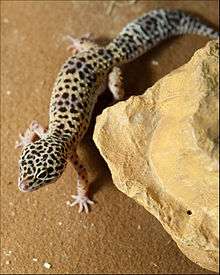Afghan leopard gecko
| Afghan leopard gecko | |
|---|---|
| Scientific classification | |
| Kingdom: | Animalia |
| Phylum: | Chordata |
| Class: | Reptilia |
| Order: | Squamata |
| Suborder: | Lacertilia |
| Family: | Gekkonidae |
| Subfamily: | Eublepharinae |
| Genus: | Eublepharis |
| Species: | E. macularius |
| Subspecies: | E. m. afghanicus |
| Trinomial name | |
| Euplepharis macularius afghanicus Börner 1976 | |
The Afghan leopard gecko (Eublepharis macularius afghanicus) is one of the five subspecies of the common leopard gecko, a small to midsized lizard belonging to the family Gekkonidae. This subspecies was first discovered by entomologist Carl Julius Bernhard Börner in 1976. It is much smaller than other leopard gecko subspecies.
Distribution and habitat
The Afghan leopard gecko is native to southeastern Afghanistan along the Kabul River and its tributaries, its range extending into northern Pakistan. It can be found in the Hindu Kush Mountains. Its habitat includes rocky desert and sparse grassland, but it avoids sand. It does not live in large colonies and is most active in April and May.
Appearance

The adult is pale to bright yellow dorsally, with scattered black or blue spots. There is a continuous light vertebral stripe. There are dark or light reticulations (netlike patterns) on the head. The limbs are blotched and the tail has irregular dark markings. The juvenile typically has three yellow bars along the back.
The male is about 15 centimeters long from snout to tail-tip. Females average about 14 centimeters.
Care
The Afghan leopard gecko is sometimes kept in captivity or as a pet. A ten-gallon aquarium is appropriate for one pair of geckos, with more space required for more animals. The male is territorial, making it difficult to keep more than one in a tank.
The gecko needs a similar habitat to many other reptiles. The tank should be monitored for temperature. The warmer area in the tank should be about 90°F and the cool end should be in the mid- to upper 70s. Heat lamps are used in daylight hours and turned off at night.
The substrate in the tank should not be sand, since the gecko avoids it in the wild. And it can also cause impaction issues, which may lead to an unpleasant death.
Because moisture helps the gecko to shed, the gecko-keeper may provide a moist hiding place. The gecko also rubs against rough surfaces to remove old skin. The gecko-keeper may assist in removal of skin from between the toes, dipping the feet into warm water to loosen it.
The Afghan leopard gecko in captivity should be offered as many crickets or other small insects as it will eat per day. Never should a gecko-keeper offer a small pinky mouse to any Leopard Gecko, because the geckos system (while not appearing to be affected) will suffer. These animals are insectivores and pinky mice are obviously not insects. The water bowl should contain one to one and a half inches of water for adult geckos. Juveniles can drown in under 2 centimeters of water, so less is required for small geckos.
Afghan leopard geckos are solitary, seeking out other geckos only during breeding time. While pairs in the same cage can work, it is ill-advised to do anything except keep each gecko separate of any others.
Little or no selective breeding is done in captivity.